AP BIOLOGY FINAL EXAM
1/179
There's no tags or description
Looks like no tags are added yet.
Name | Mastery | Learn | Test | Matching | Spaced |
|---|
No study sessions yet.
180 Terms
Humans produce sweat as a cooling mechanism
to maintain a stable internal temperature. Which
of the following best explains how the properties
of water contribute to this physiological process?
The high heat of vaporization of water
allows the body to remove excess heat
through a phase change of water from
liquid to gas
A student placed a semipermeable membrane
inside a U-shaped channel with two chambers,
as shown. The membrane permits the movement
of water but not salt. The student wants to vary
the rate of osmosis that occurs across the
membrane. Which of the following
experimental designs will result in the fastest net
rate of water movement into chamber A?
Placing salt water in chamber A and
distilled water in chamber B
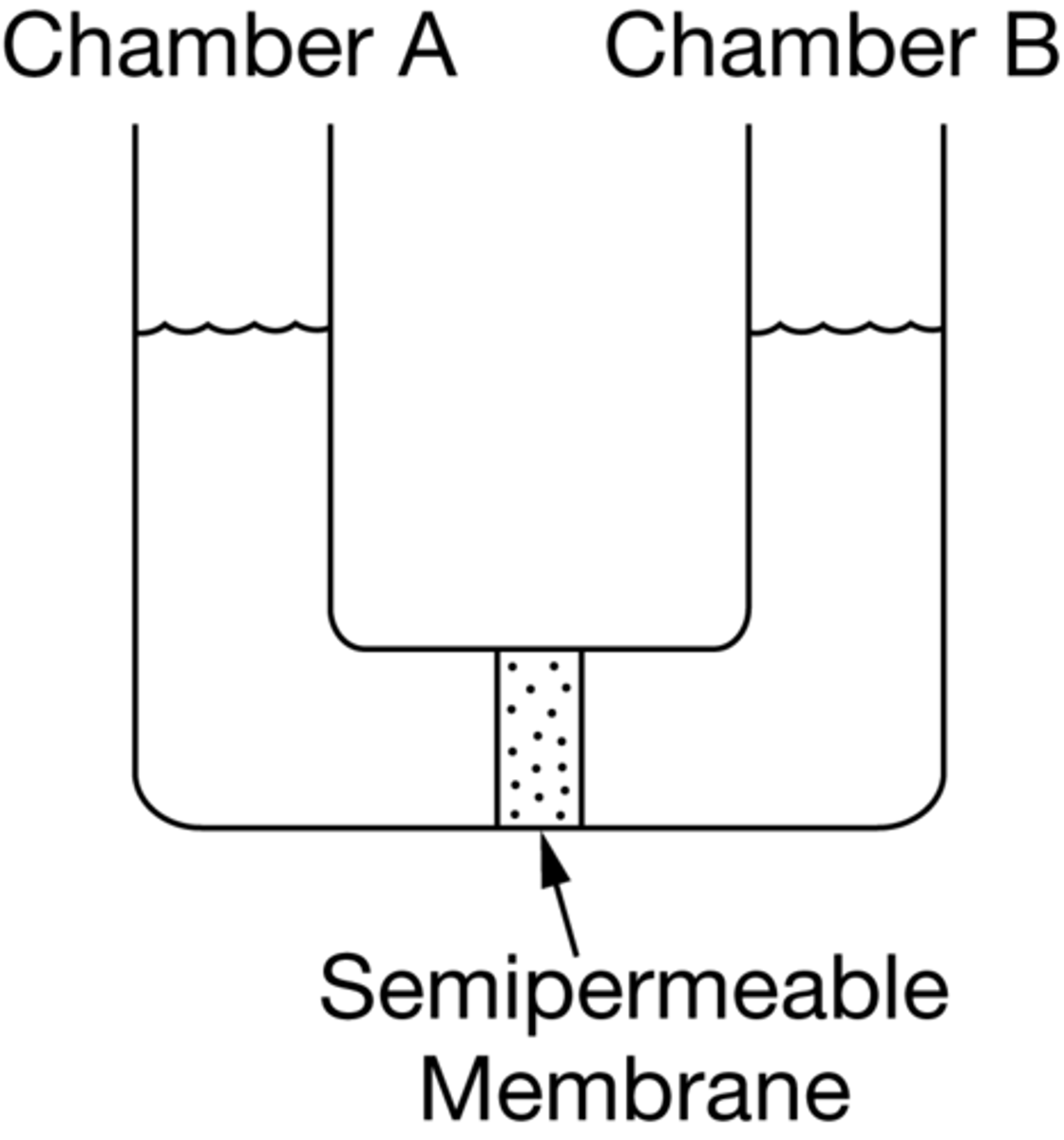
Which of the following best describes the role of
water in photosynthesis?
Water molecules donate electrons to the
electron transport chain
What evolutionary advantage does
compartmentalization of core metabolic
processes offer eukaryotes?
Evolution of a nucleus in eukaryotes
separates the processes of transcription
and translation and they can be regulated
separately
Which of the following best describes the
cellular location where pyruvate dehydrogenase
is most likely active?
The mitochondrial matrix
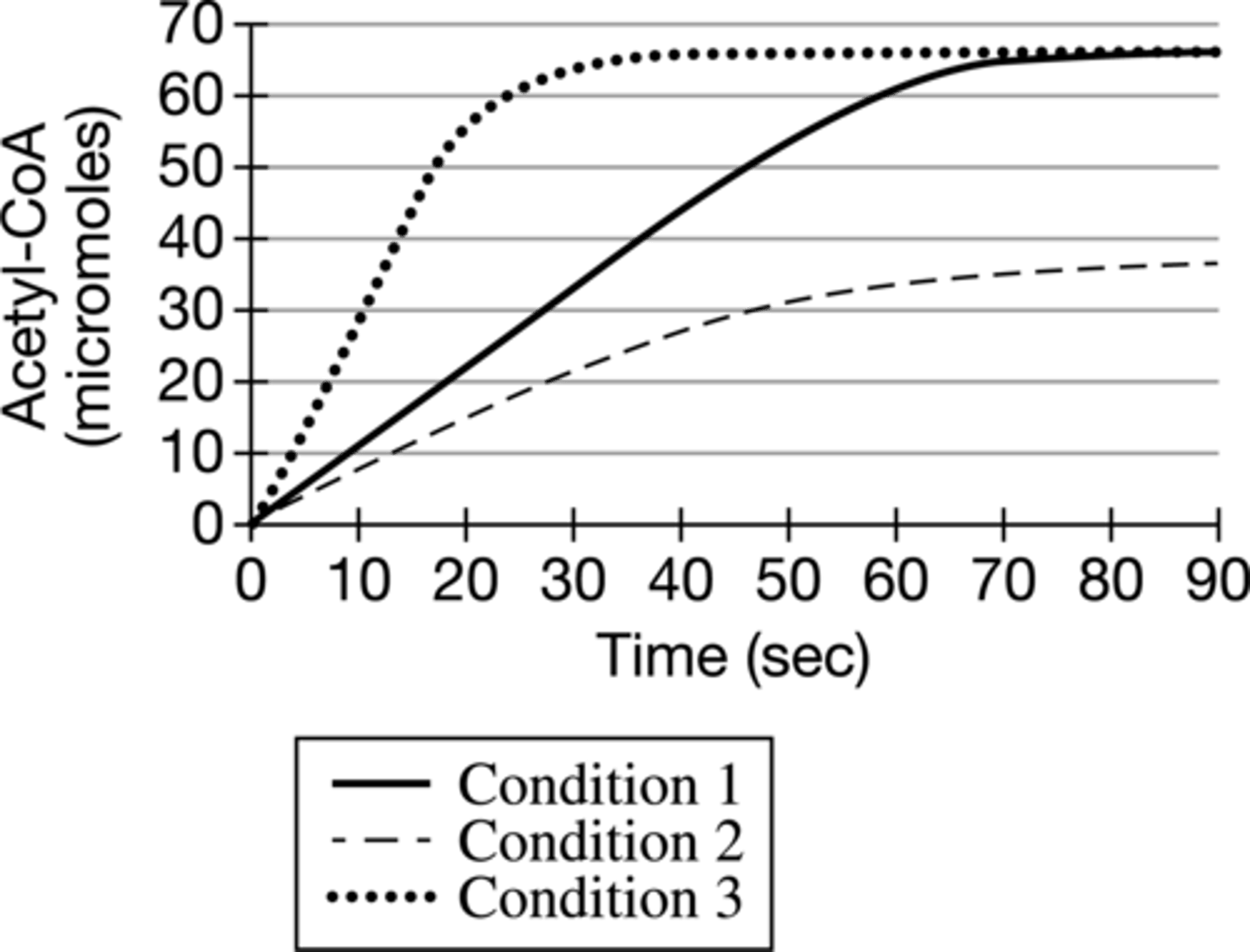
The maximum production rate of acetyl-CoA
under condition 1 is closest to which of the
following?
1 micromole/sec
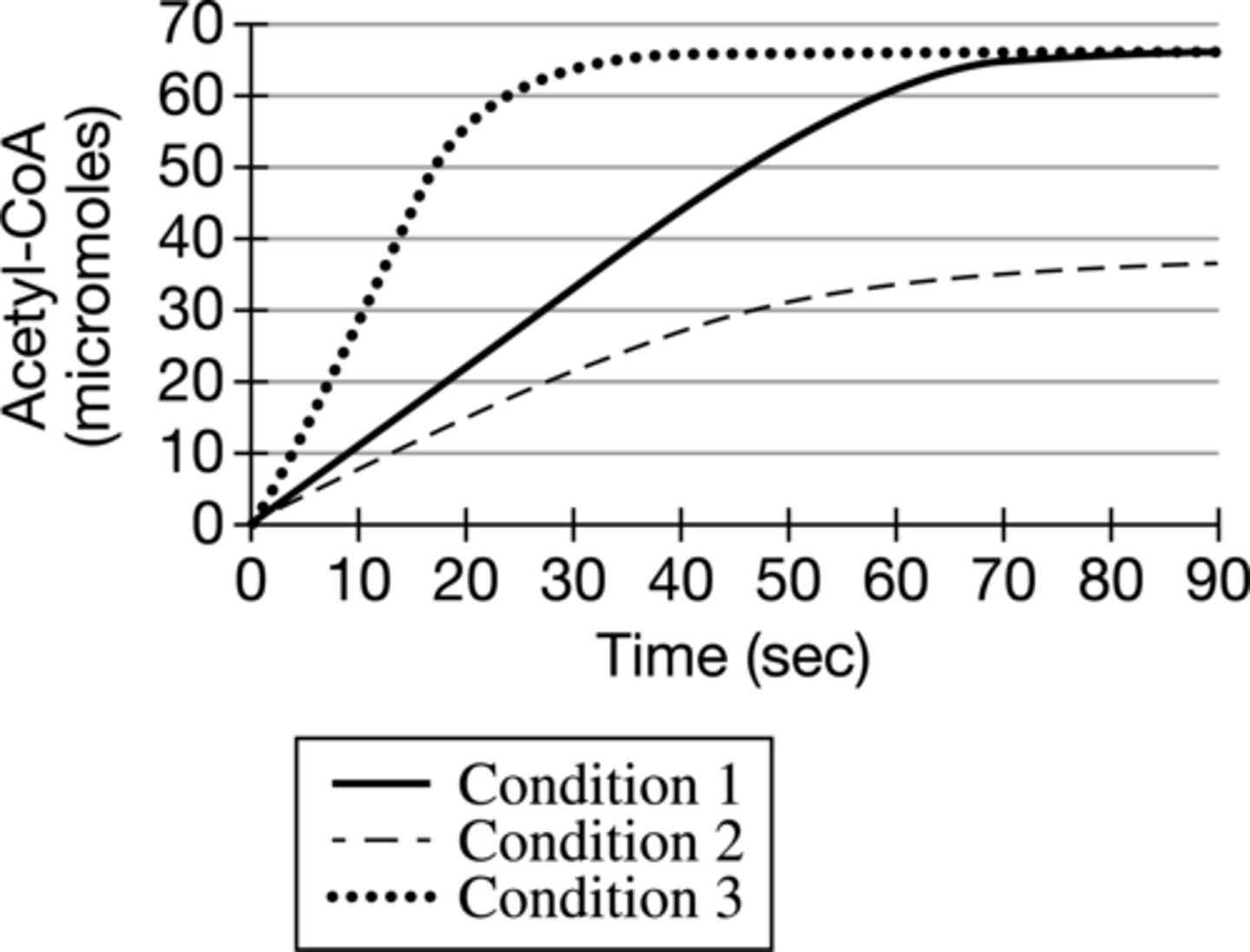
Which of the following observations provides
the best evidence that acetyl-CoA negatively
regulates pyruvate dehydrogenase activity?
The rate of the pyruvate
dehydrogenase-catalyzed reaction is
slower in the presence of a higher
concentration of acetyl-CoA
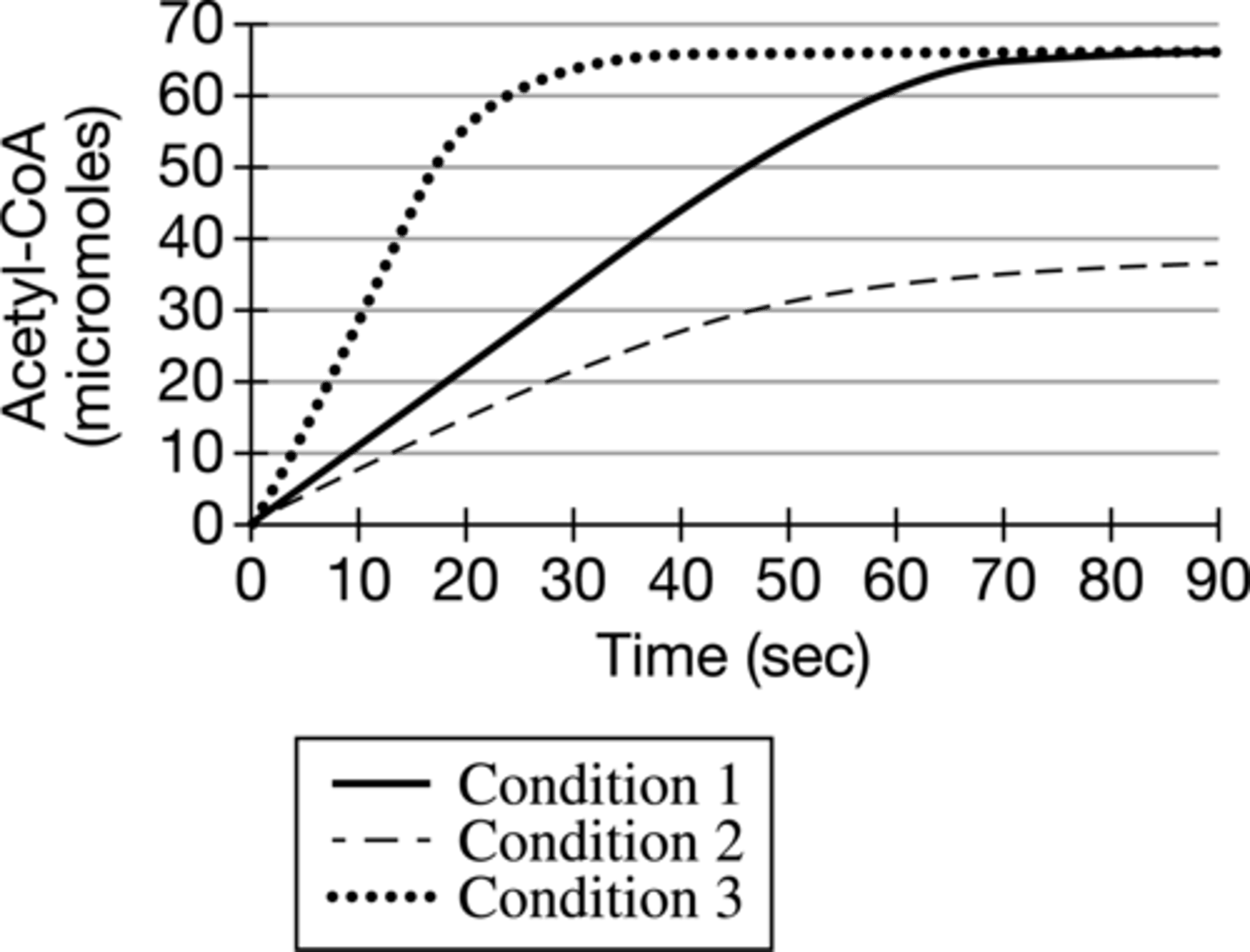
Pyruvate dehydrogenase deficiency is a genetic
disease most commonly linked to a mutation in
the a -subunit of the mitochondrial enzyme that
causes the enzyme to cease functioning. As a
result of the mutation, affected individuals build
up dangerous amounts of lactic acid. Which of
the following best explains the buildup of lactic
acid in individuals with the mutation?
Cells undergo fermentation because
pyruvate cannot be metabolized to
proceed into the Krebs cycle
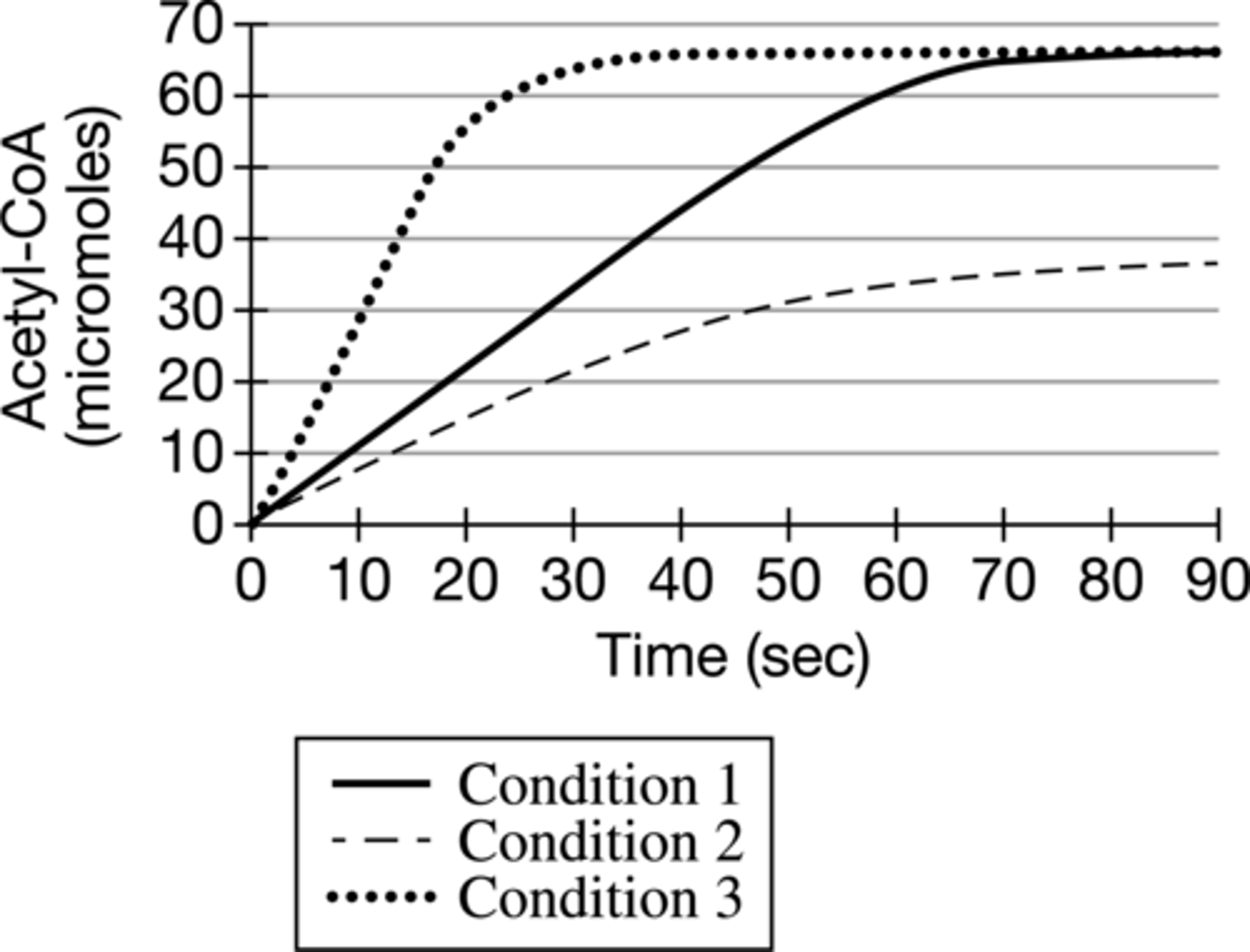
The diagram shows how water can adhere to the
xylem in the stems of plants, which contributes
to water movement in the plant. Which of the
following best explains how water is able to
move upward from the roots of a plant, through
its xylem in the stem, and out to the leaves?
Water and the xylem are both polar. Water
molecules have the ability to form
hydrogen bonds with each other and with
the walls of the xylem
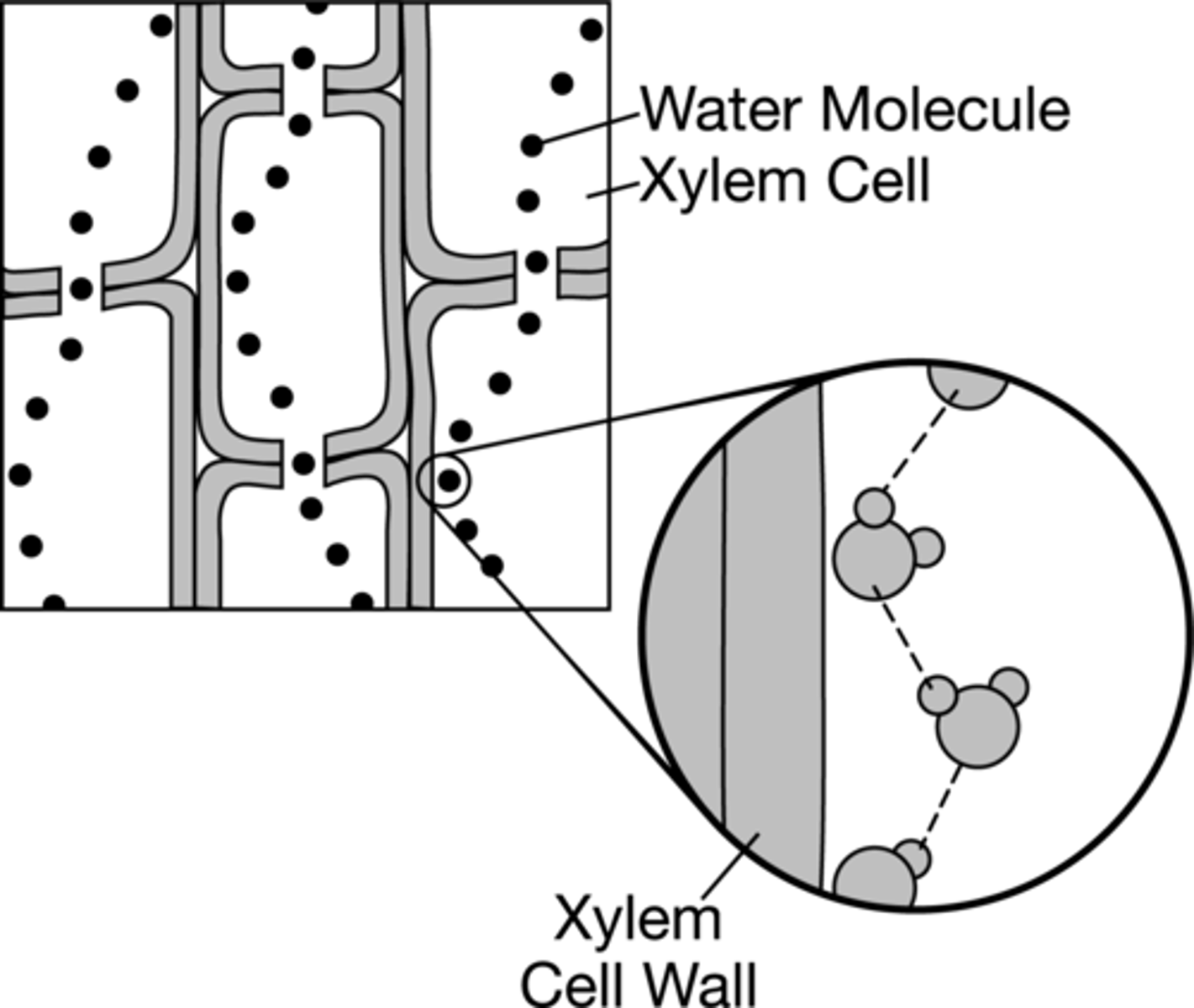
Protein X activates gene expression only in cells
exposed to a specific signaling molecule. In a
study, researchers determined the intracellular
location of Protein X in cultured cells both
before and after exposing the cells to the
signaling molecule. The results of the study are
shown in the diagram
Protein X is a transcription factor
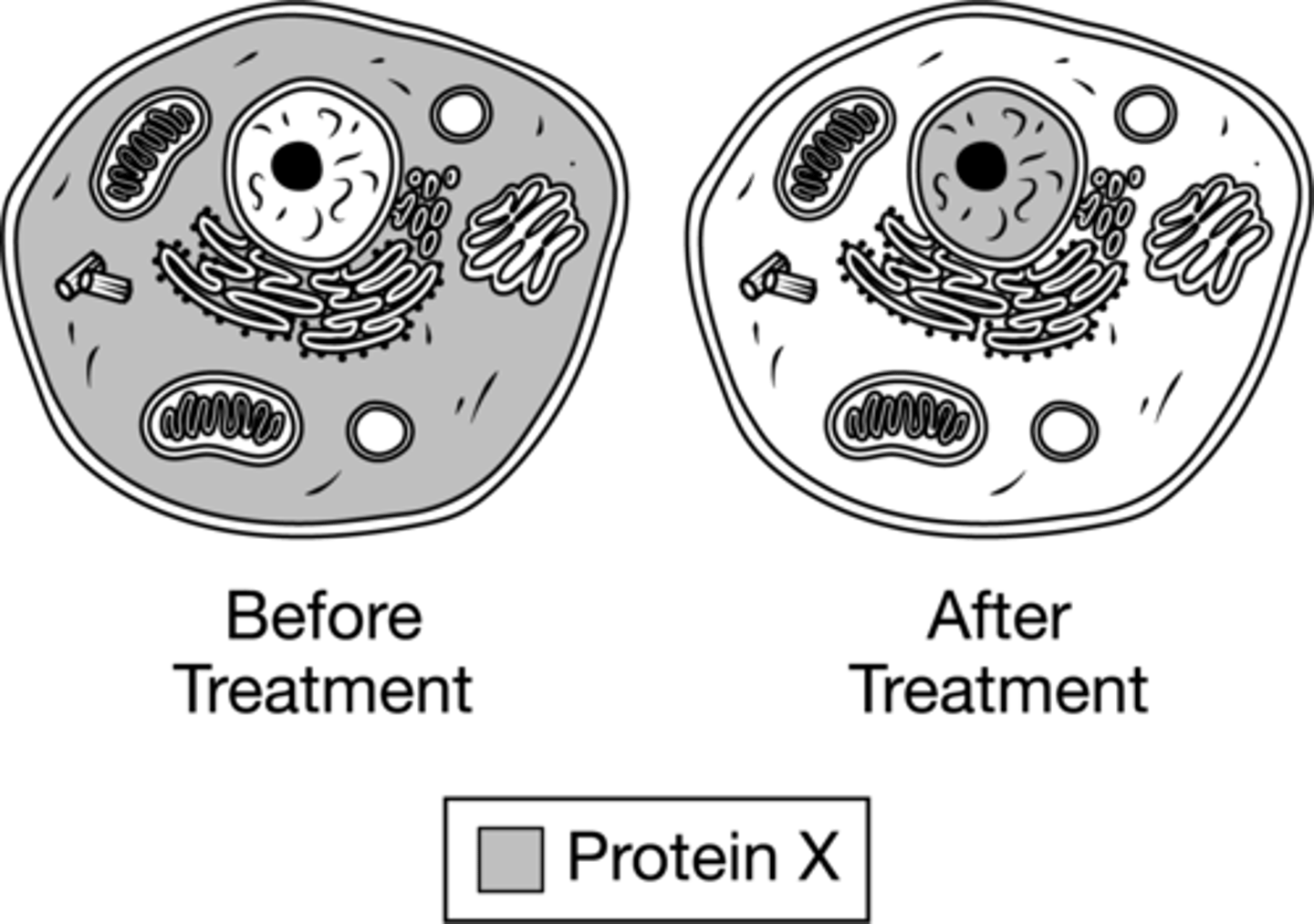
The hormone prolactin has varying effects in
many different animal species. All vertebrates
produce prolactin, which is involved in signal
transduction pathways. In mammals, prolactin
stimulates the production of milk in mammary
glands. In fish, prolactin plays an important role
in osmoregulation. In birds, prolactin is
involved in lipid metabolism.
Which of the following best explains the
presence of prolactin in various vertebrate
species?
Prolactin is a homologous hormone
because it has a common origin but
different functions in various species
Which of the following best describes the
production of DMSP by coral and coral
symbionts?
A negative feedback mechanism that
reverses the environmental change
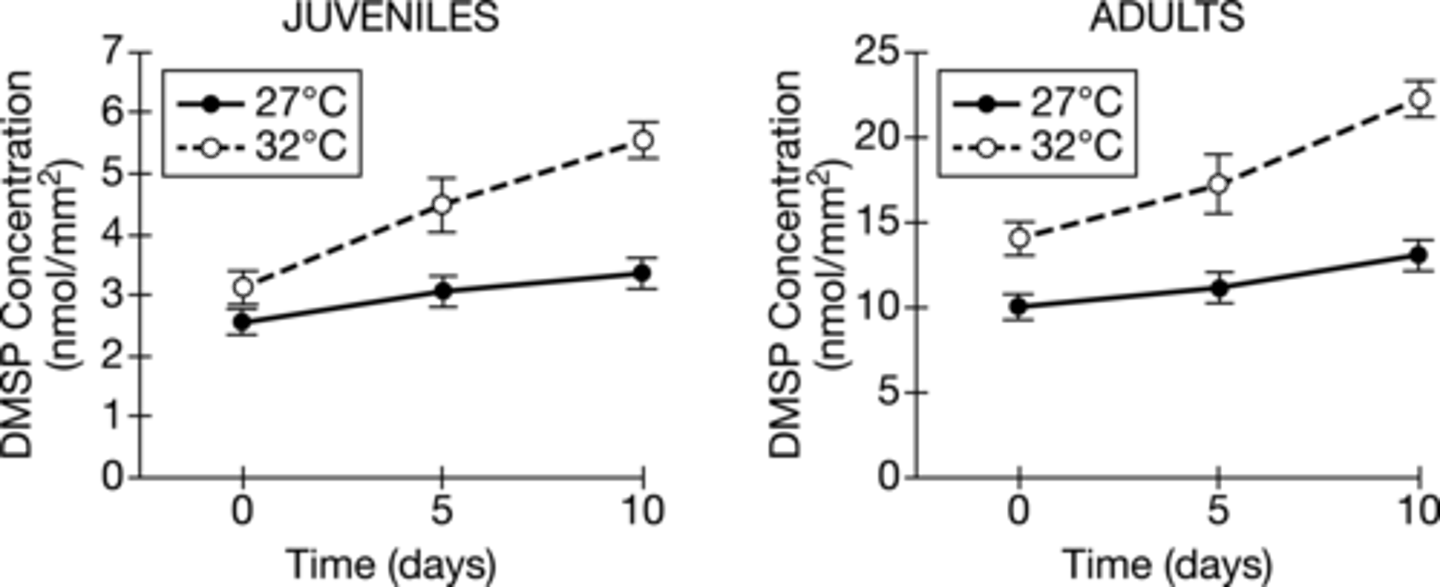
Which of the following best describes the effect
of temperature on corals' ability to produce
DMSP as shown in Figure 1 ?
Both juvenile and adult corals produce less
DMSP at 27°C than at 32°C
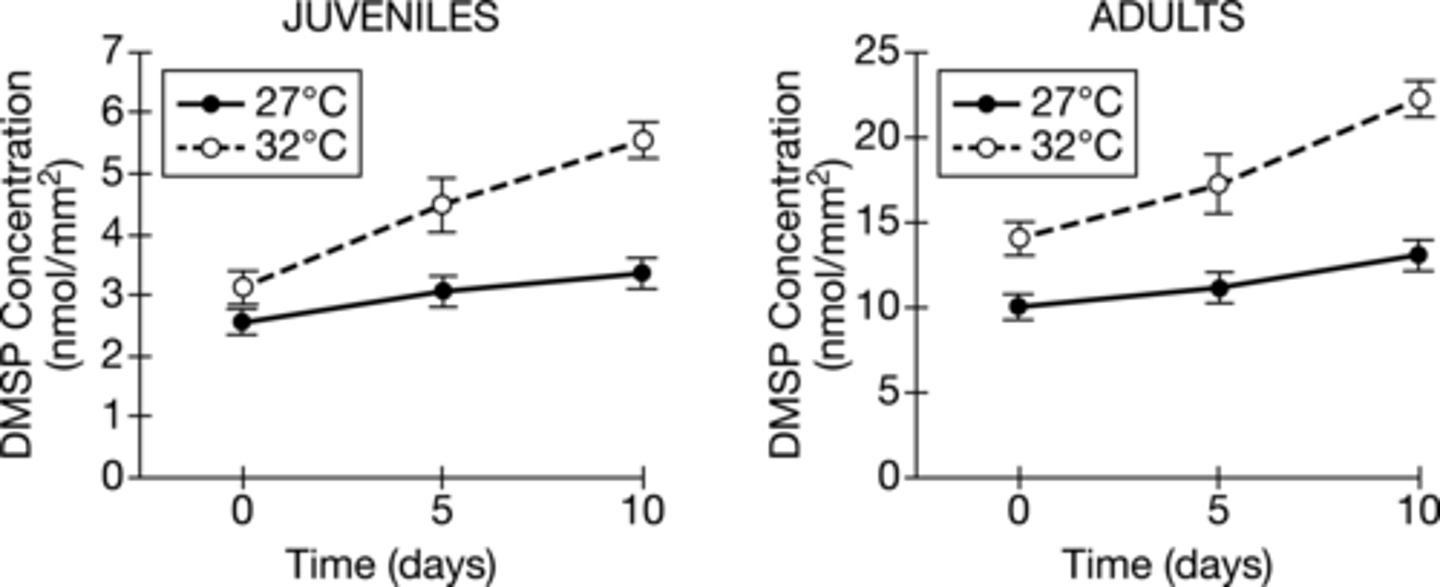
Which of the following best describes the
difference between the total amount of DMSP
produced by adults compared to juveniles at the
start of the 32°C trial?
Adult corals produced 5 times more DMSP than juveniles produced.
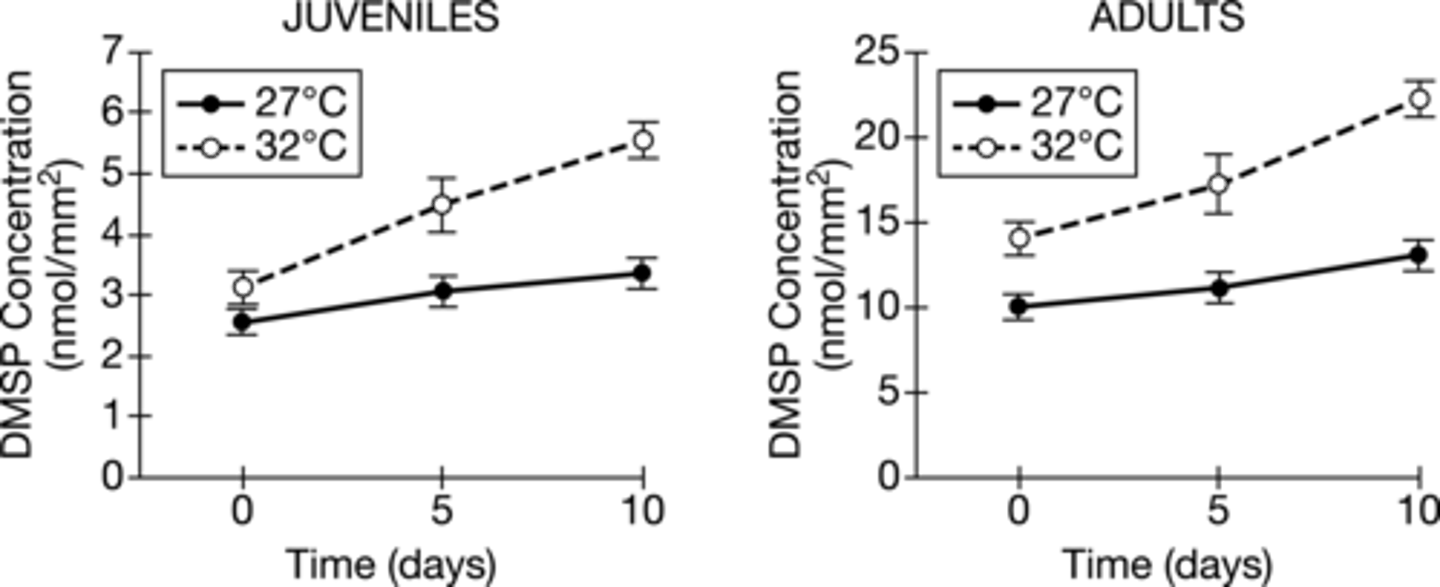
In addition to the effect of temperature on
DMSP produced by corals and their symbionts,
which of the following relationships is also
being considered in this experiment?
Effect of additional DMSP produced by
symbionts and the corals' age

Which of the following best describes the
scientists' findings concerning the density of
symbionts presented in Figure 2 ?
The symbiont density at 32°C was
different from the density at 27°C on
days 5 and 10 of the experiment
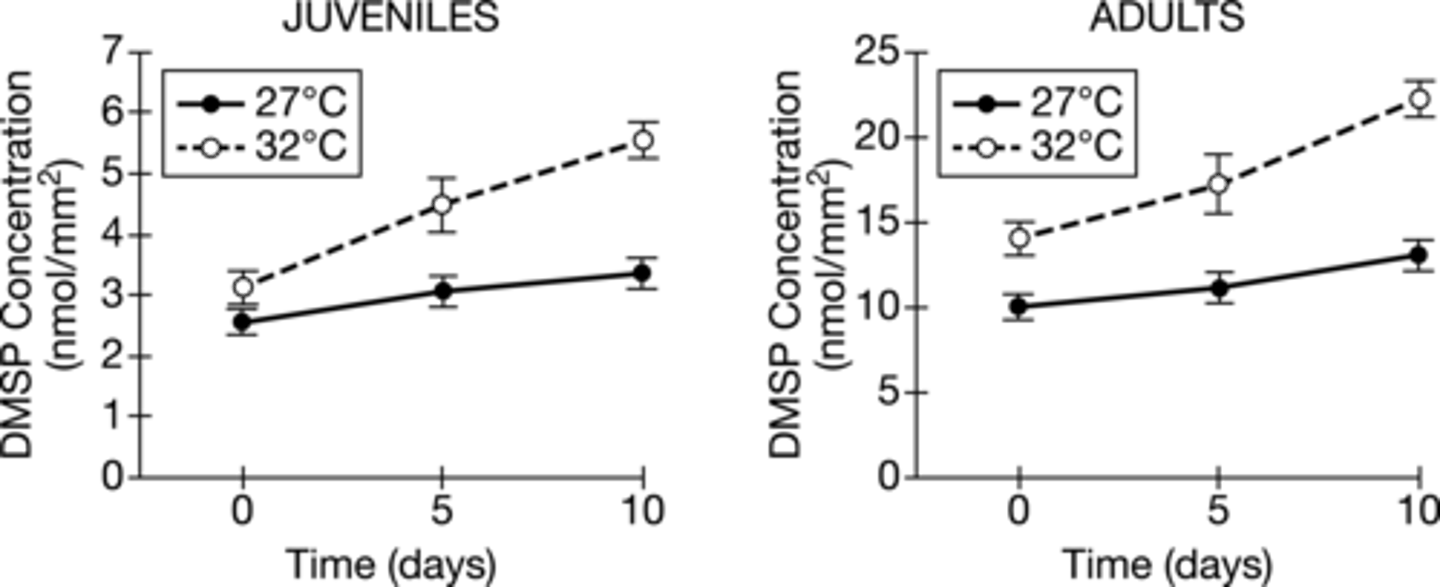
Which of the following best explains the result
of adult corals being exposed to elevated
temperatures for extended periods?
They are able to obtain less energy from
their symbionts because the algae have
been expelled
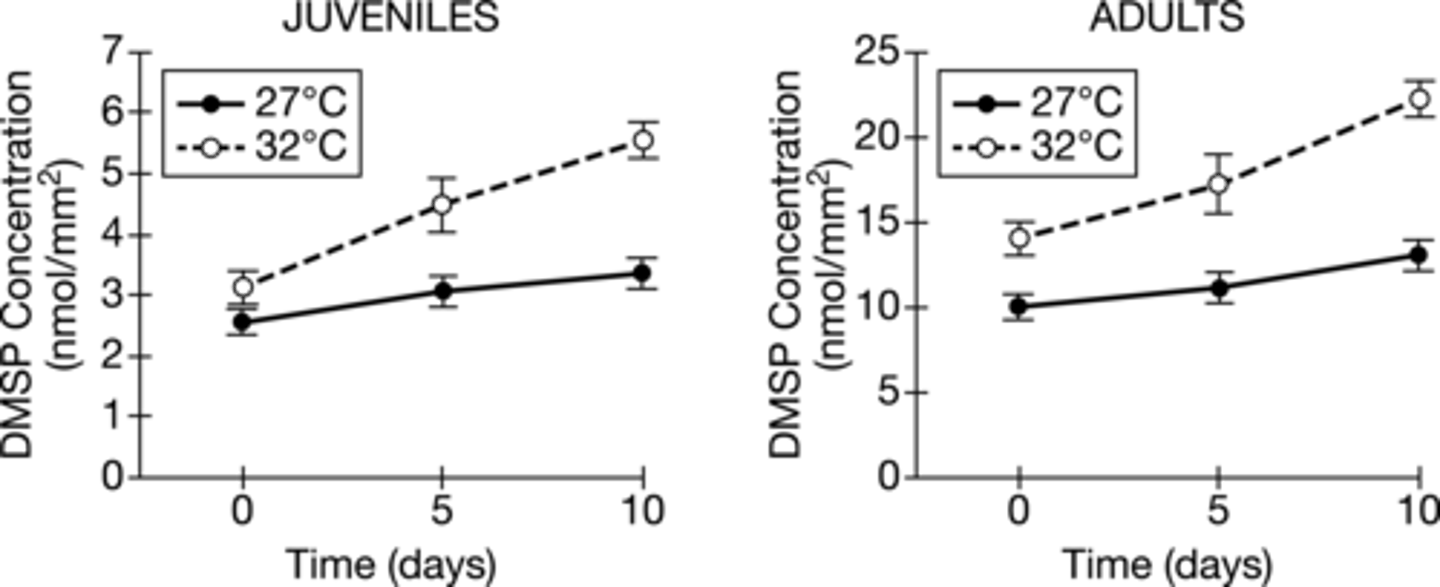
A particular gene has two alleles, a dominant
allele A and a recessive allele a. The frequency
of allele A is 0.55. If the population is in
Hardy-Weinberg equilibrium with respect to the
gene, then what is the expected frequency of
genotype Aa ?
0.495
Based on the codon chart above, which of the
following amino acid changes is most likely
found in the mutated protein?
Glu → Val
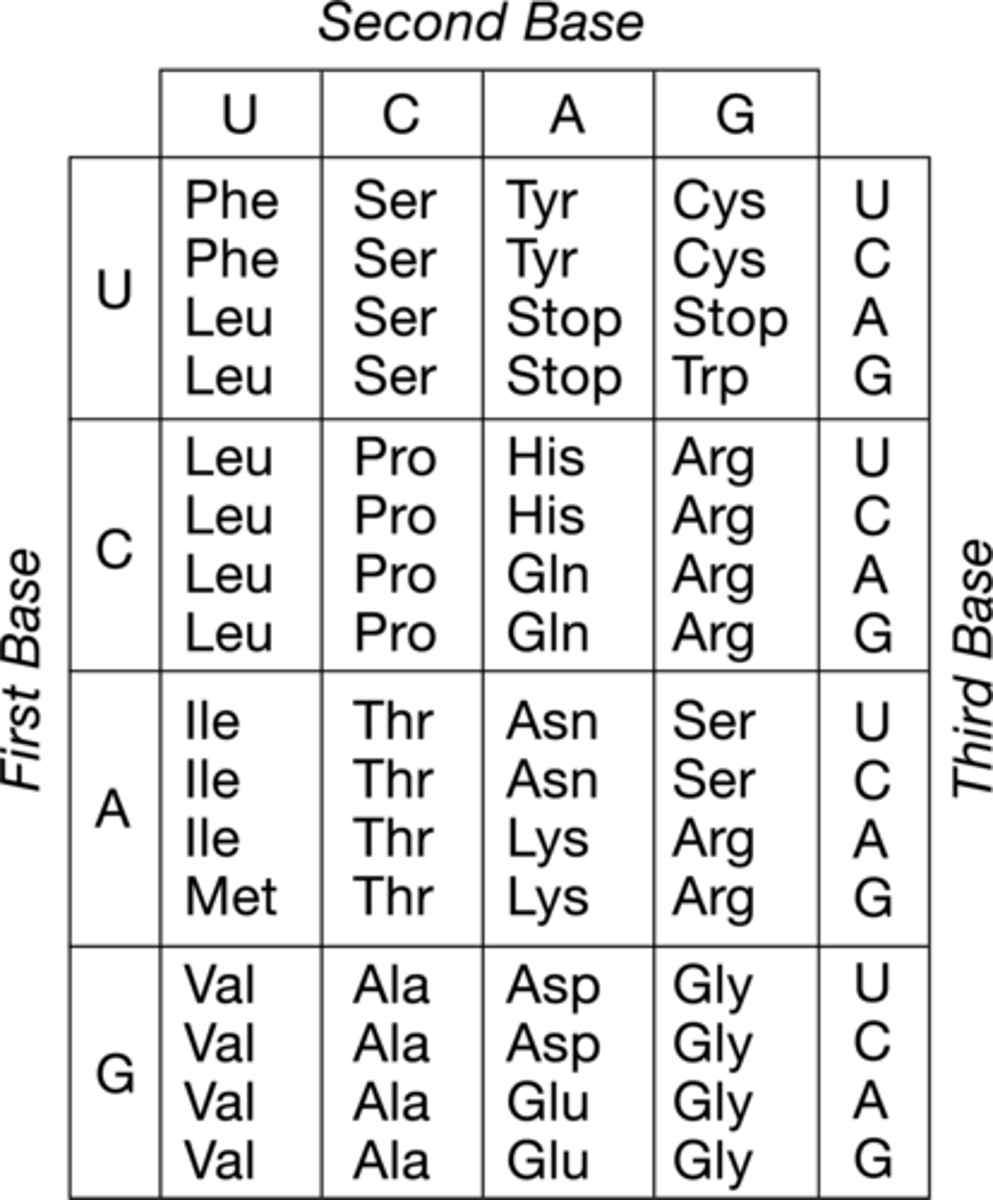
Figure 1 shows the inheritance of a particular
genetic condition in three generations of one
family. Which of the following best explains the
observed pattern of inheritance?
The condition is passed from mothers to
offspring via a mitochondrial gene
Oncogenes are genes that can cause tumor
formation as a result of a particular mutation.
Which of the following potential therapies
would be most effective at preventing the
expression of an oncogene?
Introducing a chemical that binds to
transcription factors associated with the
oncogene's promoter
Ultraviolet (UV) radiation can damage DNA by
breaking weak bonds. Which of the following
best explains how this occurs?
UV radiation disrupts the double helix
structure by breaking the hydrogen bonds
between the nitrogenous base pairs
Based on the data in the table, which of the following lizard species are most closely related?
Species E and species D
Figure 1 shows a model of the endocrine
signaling pathway that regulates ovulation.
Which of the following observations would
provide evidence of a positive feedback
mechanism in this system?
Estrogen from the ovaries stimulates the
hypothalamus and anterior pituitary to
secrete more GnRH, LH, and FSH
In which of the following tubes did the greatest
reduction of DCPIP occur after 60 minutes?
Tube 2
Which of the following claims is best supported
by the experimental results?
Light is required for the electron transport
chain to transfer electrons
Which of the following best explains how
DCMU affected the reaction?
DCMU acts as an inhibitor to the
movement of electrons within the light
reaction of photosynthesis
Which of the following best justifies the use of
tube 2 as a control treatment?
It was a positive control for measuring the
effect of DCMU on the reaction
A scientist designed an experiment to test an
artificial membrane that mimics the
phospholipid bilayer of a cell.
The scientist built a tube that was divided by an
artificial membrane and filled with distilled
water. The scientist put a known amount of a
protein into the water on one side of the
membrane. After some time, the scientist
measured the concentration of the protein on
either side of the membrane but found that there
had been no change.
Which of the following experimental changes
would allow the scientist to observe transport of
a solute across the artificial membrane?
Use a small, nonpolar solute instead of a
protein
Which of the following best illustrates the flow
of information required for the synthesis of
proteins encoded in the genome of a retrovirus?
RNA-->DNA-->RNA-->Protein
Which of the following best describes the
process by which gas from the atmosphere is
obtained by plants and used to build lipids?
Gas is directly obtained by plants as part of
the carbon cycle
Which of the following best explains how the
phospholipid bilayer of a transport vesicle
contributes to cellular functions?
The phospholipid bilayer allows the vesicle
to fuse with the Golgi apparatus and the
plasma membrane, allowing the
exocytosis of proteins
The diploid number of chromosomes in the cell
of a domesticated dog is 78. Which of the
following options includes the correct number of
chromosomes in a cell after each cellular process
(G2 checkpoint, meiosis, and fertilization,
respectively)?
After G2 checkpoint: 78, After Meiosis: 39, After Fertilization: 78
Based on the data in the table, which of the following best explains the effects of rotenone on cellular
respiration?
Treated cells are not able to break down NADH because certain enzymes of the electron transport chain are inhibited
Which of the following best explains why
triploid bananas do not produce seeds?
The production of gametes is disrupted
because of unequal pairing of
homologous chromosomes during
meiosis
Which of the following best explains why the
polymerase from the species T. aquaticus is
often used for PCR ?
T. aquaticus polymerase does not denature
at high temperatures
A researcher is studying two different species.
Which of the following sets of observations
would best support the claim that the two
species have structural similarities as a result of
convergent evolution?
Genetic similarity: low, Function of structure: same, Form of structure: different
Based on the cladogram, which of the following
are the traits shared between ferns and pines?
Embryo and xylem only
The researchers performed a chi-square analysis to test their hypothesis. Assuming the researchers use a
significance level of 0.05, which of the following is closest to the critical value the researchers should use in
the chi-square analysis?
3.84
Which of the following best describes what
happened to the otter population between 1750
and 1850 ?
The population lost genetic diversity as a
result of a bottleneck effect
Based on the information provided in the
passage, which of the following best describes
the effect of harmful algal blooms on otter
populations?
They are a density-independent factor that
negatively affects the otter population
regardless of its size
As otters were removed during the hunting
years, there was a large decrease in the catches
of fish species from the eelgrass habitats. Which
of the following best explains why this decrease
happened?
Otters are a keystone species, so their
disappearance from the area resulted in
the collapse of an entire community
Climate change could affect the ecosystem of
the Elkhorn Slough in many ways. From the
information provided, which of the following
predictions about the direct, local effects of
climate change is most likely?
Ocean warming will favor population
growth of nonnative species as their
habitats shift northward
Based on the information, an increase in the sea
slug population would most likely be directly
related to which of the following?
A decrease in the crab population
Many fish species, such as fathead minnows,
release a pheromone when their skin cells are
damaged. Researchers placed pike, a predator of
fathead minnows, in a choice chamber and
released the minnow pheromone at one end of
the chamber. The researchers observed that the
pike oriented themselves toward the end of the
chamber where the pheromone was released.
Which of the following questions will best guide
a follow-up investigation about the role of
pheromones in locating prey?
How do pike determine that the fathead
minnow pheromone is present in the
water?
Which of the following best explains why a
cell's plasma membrane is composed of two
layers of phospholipids rather than just a single
layer?
Having two oppositely oriented layers of
phospholipids allows only the hydrophilic
heads to interact with water inside and
outside of the cell
Based on the data, which type of cell would be
best suited for the lining the alveoli of the lungs,
where diffusion of carbon dioxide and oxygen
must occur very rapidly?
Simple squamous cells
Which of the following best explains how the
extensive folding of the inner mitochondrial
membrane benefits a eukaryotic cell?
It increases the area available for proteins
involved in energy transfer
Some green sea turtle females deposit their eggs
in nests that are dug on warm, tropical beaches.
Researchers have studied the effects of
temperature on the hatching rate and the
proportion of female to male hatchlings
produced at different average nest temperatures
in Suriname (Figure 1). At temperatures below
23°C or above 33°C, the eggs do not develop.
Which of the following best describes the results
shown in Figure 1 ?
Warmer nests produce more female sea
turtles than do cooler nests
Which of the following describes a scenario that
would result in the phenotypic change shown in
the graph?
House sparrows that lay
smaller-than-average clutches of eggs
produce fewer viable offspring, while
larger-than-average clutches of eggs result
in malnourished chicks that have a higher
mortality rate
Which of the following best explains the most
likely method by which this antitumor drug
works?
Trabectedin interferes with the duplication of DNA during interphase and thus prevents cancer cells from passing the G checkpoint
Based on the data in Figure 1, which of the
following best describes the inheritance pattern
of Friedreich's ataxia?
Autosomal recessive
The probability that individual III-5 will
develop Friedreich's ataxia is closest to which of
the following?
25%
Which of the following statements best describes
the results seen in Figure 2 ?
Individuals III-2 and III-3 carry two
different alleles of the FXN gene, a
mutant allele and a wild-type allele.
Individual IV-1 inherited two copies of
the mutant allele
Which of the following best describes the most
likely effect of the formation of a triplex DNA
structure (Figure 3) on the synthesis of the
frataxin protein?
RNA polymerase is prevented from
binding to the DNA, resulting in a
decrease in frataxin mRNA transcription
Which of the following types of bonds is most
likely responsible for the unusual base pairing
shown in Figure 3 that results in the formation of
a triplex DNA structure?
Hydrogen
Which of the following values is closest to the
chi-square value the scientist calculated?
23.1
Which of the following research questions would best guide an investigation of the link between the structure
of the signaling molecules and the evolution of quorum sensing?
Did these species evolve from a common ancestor that used a similar signaling molecule?
Carbon dioxide most likely enters a cell through
which of the following processes?
Simple diffusion through the membrane
In pea seeds, yellow color (Y ) is dominant to
green color (y), and a round shape (R) is
dominant to a wrinkled shape (r). A dihybrid
cross between a true-breeding plant with yellow,
round seeds (YYRR) and a true-breeding plant
with green, wrinkled seeds (yyrr) results in an
F1 generation of plants with yellow, round
seeds. Crossing two F1 plants produces an F2
generation with approximately nine times as
many plants with yellow, round seeds as plants
with green, wrinkled seeds.
Which of the following best explains these
results?
The genes for seed color and seed shape
assort independently
Which of the following best describes the hydrolysis of carbohydrates?
The addition of a water molecule breaks a covalent bond between sugar monomers.
Which of the following best describes a characteristic of DNA that makes it useful as hereditary material?
Nucleotide bases in one strand can only be paired with specific bases in the other strand.
Based on the pedigrees in Figure 1, which of the following best explains the observed pattern of inheritance?
The trait is autosomal recessive, because the cross between individuals I-1 and I-2 produced an affected offspring.
Which of the following best describes the process by which the bacteria are breaking down the glucose to produce lactic acid?
The bacteria are breaking down sugars in the absence of oxygen.
Which of the following was the dependent variable in the researcher's experiment?
pH
To investigate bacterial metabolism, a researcher divided a population (culture) of Staphylococcus capitis bacteria into two sets of culture tubes containing glucose. The researcher added a chemical to one set of tubes and measured the pH of the cultures at 5-minute intervals as the bacteria metabolized the glucose into lactic acid. The data are shown in Table 1.
TABLE 1. AVERAGE CHANGE IN pH IN CONTROL AND TREATMENT GROUPS OVER A 40-MINUTE PERIOD
This graph shows the decreasing pH values and error bars over time for both the control and treatment cultures.
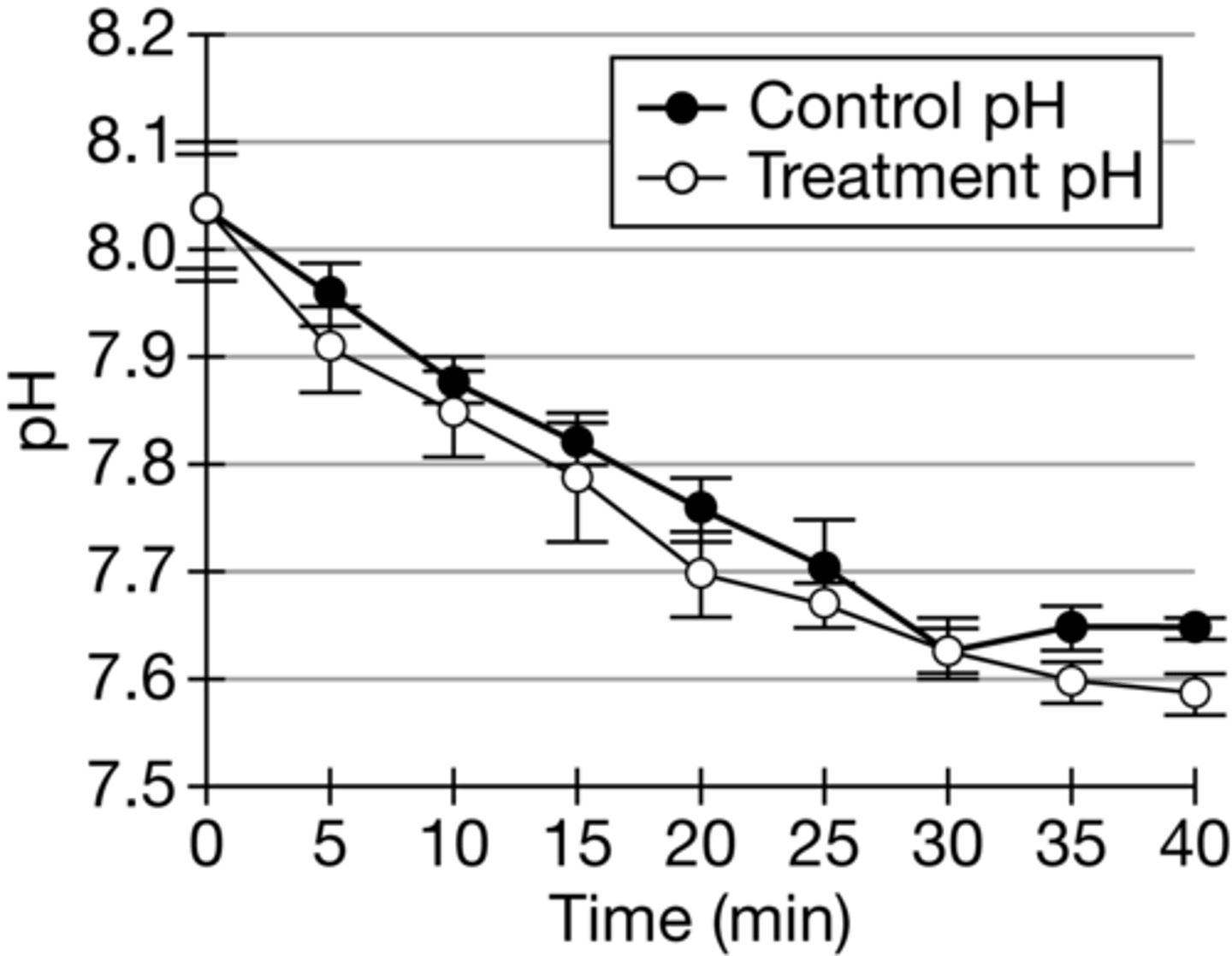
To investigate bacterial metabolism, a researcher divided a population (culture) of Staphylococcus capitis bacteria into two sets of culture tubes containing glucose. The researcher added a chemical to one set of tubes and measured the pH of the cultures at 5-minute intervals as the bacteria metabolized the glucose into lactic acid. The data are shown in Table 1.
TABLE 1. AVERAGE CHANGE IN pH IN CONTROL AND TREATMENT GROUPS OVER A 40-MINUTE PERIOD
35 minutes
To investigate bacterial metabolism, a researcher divided a population (culture) of Staphylococcus capitis bacteria into two sets of culture tubes containing glucose. The researcher added a chemical to one set of tubes and measured the pH of the cultures at 5-minute intervals as the bacteria metabolized the glucose into lactic acid. The data are shown in Table 1.
According to the data, which of the following best explains the results of the experiment?
The pH of the treatment culture was lower than the pH of the control because the chemical increased the bacterial metabolic rate
A mutation in the gene coding for a single-polypeptide enzyme results in the substitution of amino acid serine, which has a polar R group, by the amino acid phenylalanine, which has a non polar R group. When researchers test the catalysis of the normal enzyme and the mutated enzyme, they find that the mutated enzyme has much lower activity than the normal enzyme does.
Which of the following most likely explains how the amino acid substitution has resulted in decreased catalytic activist by the mutated enzyme?
The substitution altered the secondary and tertiary structure of the enzyme so that the mutated enzyme folds into a different shape than the normal enzyme does.
Pitcher plants are carnivorous plants that grow in areas where the soil contains low levels of key nutrient such as nitrogen. To obtain these nutrients, most pitcher plants capture prey using traps containing a digestive fluid. The captured prey are then broken down and digested, and the pitcher plant absorbs the nutrients.
The traps of one species of pitcher plant, Nepenthes hemsleyana, do not contain digestive fluid. Instead the provide a suitable place for wooly bats (Kerivoula hardwicki) to sleep. The feces from the bat are released into the trap where nutrients in the feces are absorbed and provide the plant with the nitrogen it needs.
Which of the following best describes the relationship between the pitcher plant and the wooly bat?
The relationship is an example of mutualism because both the plant and the bat benefit.
A particular genetic disorder is associated with a single gene with two alleles. Individuals with two recessive alleles are affected. The prevalence of the disorder is 1 in 6,600.
Assuming the population is in Hardy-Weinberg equilibrium, which of the following is closest to the frequency of carriers in the general population?
0.02430
Blood vessels are surrounded by called smooth muscle cells. Nitric oxide triggers a signaling cascade in smooth muscle cells that causes the cells to relax.
Which of the following is represented by the gradual increase in thickness of the arrows from the top to the bottom of Figure 1?
The number of signaling molecules that are produced or activated increases with each step in the pathway.
A student peeled the skins from grapes, exposing cells with membranes that are only permeable to water and small diffusible solutes. The student measured the mass of the peeled grapes. The student then placed each peeled grape into one of the solutions. After 24 hours, the student removed the peeled grapes from the solutions, measured their final mass, and calculated the percent change in mass (Table 1)
In a second experiment (Table 2), the student placed a peeled grape into a solution containing both small diffusible solutes and solutes in which the membrane is impermeable (nondiffusible solutes)
Based on Table 1, which of the following best explains the difference in water potential between certain solutions and the grapes?
Grape soda and NaCl have a lower water potential because these two solutions caused the grape to lose water.
A student peeled the skins from grapes, exposing cells with membranes that are only permeable to water and small diffusible solutes. The student measured the mass of the peeled grapes. The student then placed each peeled grape into one of the solutions. After 24 hours, the student removed the peeled grapes from the solutions, measured their final mass, and calculated the percent change in mass (Table 1)
In a second experiment (Table 2), the student placed a peeled grape into a solution containing both small diffusible solutes and solutes in which the membrane is impermeable (nondiffusible solutes)
Based on Table 1, which of the following percentages is closest to the solute concentration of the grape?
5.5%
A student peeled the skins from grapes, exposing cells with membranes that are only permeable to water and small diffusible solutes. The student measured the mass of the peeled grapes. The student then placed each peeled grape into one of the solutions. After 24 hours, the student removed the peeled grapes from the solutions, measured their final mass, and calculated the percent change in mass (Table 1)
In a second experiment (Table 2), the student placed a peeled grape into a solution containing both small diffusible solutes and solutes in which the membrane is impermeable (nondiffusible solutes)
Based on the data in Table 1, which of the following best evaluates the student's hypothesis?
The hypothesis is not supported because the mass of the grape increased in the grape juice.
A student peeled the skins from grapes, exposing cells with membranes that are only permeable to water and small diffusible solutes. The student measured the mass of the peeled grapes. The student then placed each peeled grape into one of the solutions. After 24 hours, the student removed the peeled grapes from the solutions, measured their final mass, and calculated the percent change in mass (Table 1)
In a second experiment (Table 2), the student placed a peeled grape into a solution containing both small diffusible solutes and solutes in which the membrane is impermeable (nondiffusible solutes)
Assuming a negligible pressure potential, which of the following best predicts the net movement of the small diffusible solutes and water in the second experiment (Table 2)?
Small diffusible solutes will diffuse into the grape cells, followed by water.
Mercurial sulfhydryl is an inhibitor or aquaporins. Which of the following is the most likely effect of adding mercurial sulfhydryl to the distilled water molecule?
The grape cells will gain water more slowly because of a lack of facilitated diffusion.
Which of the following best explains why larger grapes have a different rate of water absorption per gram of mass than smaller grapes do?
The rate is slower because smaller grapes have a larger surface-area-to-volume ratio than the larger grapes do.
Which of the following best explains how some cells of an individual proceed and secrete a specific enzyme, but other cells of the same individual do not?
The cells transcribe and translate different combinations of genes, leading to the production of different sets of proteins.
Figure 1 shows the amount of product produced in an enzyme-catalyzed reaction over five minutes. Which of the following best explains how the rate of the reaction changes over time?
The rate decreases because the ratio of product to substrate increases.
Pyruvate kinase, a key enzyme in the glycolysis pathway, is inhibited by the amino acid alanine. The ability of alanine to inhibit the enzyme is not affected by increasing the concentration of substrate.
Which of the following best explains the mechanism by which alanine inhibits pyruvate kinase activity?
Alanine binds to an allosteric site of the enzyme, changing the shape of the enzyme's active site.
Different species of bumblebee compete for flower nectar in their ecosystem. While the flowers vary in the length of their petals, bumblebees vary in the length of a mouth part called a proboscis. Bumblebees demonstrate a preference for flowers that correspond to the length of the proboscis. Species with proboscises of similar length tend to occupy different areas. Species that live in the same area tend to have proboscises of different lengths.
which of the following best explains the relationship between the different bumblebee species living in the same area?
The bumblebees have undergone niche partitioning due to competition.
Researchers investigated whether time of day affects the rate at which certain mRNAs produced by plants are broken down. At either 1 hour after the start of the light period (morning) or 8 hours after the start of the light period (afternoon), the researchers treated identical plant seedlings with a compound that blocks transcription (time = 0 min). The researchers measured the percent remaining of two mRNAs, mRNA G, and mRNA H over the course of 120 minutes. The data is shown in Figure 1.
Based on the data, which of the following best describes the relationship between light and degradation of mRNA G and mRNA H?
A longer exposure to light increases the rate of mRNA G degradation but not of mRNA H degradation.
Which of the following observations would best provide the strongest evidence that two plants belong to different biological species?
They produce viable but sterile offspring.
Hormones are chemical signals that are released by cells in one part of the body that travel through the bloodstream to signal cells in another part of the body. Insulin is a hormone that is released by the pancreas that induces the uptake of glucose molecules from the bloodstream into cells. In this way, insulin lowers the overall blood glucose levels of the body. Osteoblasts and osteoclasts are two types of bone cells that play a role in regulating blood glucose levels (Figure 1).
Binding of insulin to the insulin receptor on osteoblasts activates a signaling pathway that results in osteoblasts releasing a molecule, OPG, that binds to the neighboring osteoclasts. In response, the osteoclasts release protons (H+) and create an area of lower pH outside the cell. This low pH activates osteocalcin, a protein secreted in an inactive form by osteoblasts.
The Esp gene encodes a protein that alters the structure of the insulin receptor on osteoblasts and interferes with the binding of insulin to the receptor. A researcher created a group of osteoblasts with an Esp mutation that prevented the production of a functional Esp product (mutant). The researcher then exposed the mutant strain and a normal strain that expresses Esp to glucose and compared the levels of insulin in the blood near the osteoblasts (Figure 2)
Based on the information provided, which of the following best justifies the claim that osteocalcin is a hormone?
The osteoblasts in the bone secrete osteocalcin, which causes cells in the pancreas to change their activity.
Hormones are chemical signals that are released by cells in one part of the body that travel through the bloodstream to signal cells in another part of the body. Insulin is a hormone that is released by the pancreas that induces the uptake of glucose molecules from the bloodstream into cells. In this way, insulin lowers the overall blood glucose levels of the body. Osteoblasts and osteoclasts are two types of bone cells that play a role in regulating blood glucose levels (Figure 1).
Binding of insulin to the insulin receptor on osteoblasts activates a signaling pathway that results in osteoblasts releasing a molecule, OPG, that binds to the neighboring osteoclasts. In response, the osteoclasts release protons (H+) and create an area of lower pH outside the cell. This low pH activates osteocalcin, a protein secreted in an inactive form by osteoblasts.
The Esp gene encodes a protein that alters the structure of the insulin receptor on osteoblasts and interferes with the binding of insulin to the receptor. A researcher created a group of osteoblasts with an Esp mutation that prevented the production of a functional Esp product (mutant). The researcher then exposed the mutant strain and a normal strain that expresses Esp to glucose and compared the levels of insulin in the blood near the osteoblasts (Figure 2).
Which of the following best describes the effect of insulin binding to the receptor on the osteoblast cells?
Insulin binding ultimately increases pancreatic secretion of additional insulin.
Hormones are chemical signals that are released by cells in one part of the body that travel through the bloodstream to signal cells in another part of the body. Insulin is a hormone that is released by the pancreas that induces the uptake of glucose molecules from the bloodstream into cells. In this way, insulin lowers the overall blood glucose levels of the body. Osteoblasts and osteoclasts are two types of bone cells that play a role in regulating blood glucose levels (Figure 1).
Binding of insulin to the insulin receptor on osteoblasts activates a signaling pathway that results in osteoblasts releasing a molecule, OPG, that binds to the neighboring osteoclasts. In response, the osteoclasts release protons (H+) and create an area of lower pH outside the cell. This low pH activates osteocalcin, a protein secreted in an inactive form by osteoblasts.
The Esp gene encodes a protein that alters the structure of the insulin receptor on osteoblasts and interferes with the binding of insulin to the receptor. A researcher created a group of osteoblasts with an Esp mutation that prevented the production of a functional Esp product (mutant). The researcher then exposed the mutant strain and a normal strain that expresses Esp to glucose and compared the levels of insulin in the blood near the osteoblasts (Figure 2).
Which of the following claims is most consistent with the data shown in Figure 2?
Esp expression is necessary to prevent the overproduction of insulin.
Hormones are chemical signals that are released by cells in one part of the body that travel through the bloodstream to signal cells in another part of the body. Insulin is a hormone that is released by the pancreas that induces the uptake of glucose molecules from the bloodstream into cells. In this way, insulin lowers the overall blood glucose levels of the body. Osteoblasts and osteoclasts are two types of bone cells that play a role in regulating blood glucose levels (Figure 1).
Binding of insulin to the insulin receptor on osteoblasts activates a signaling pathway that results in osteoblasts releasing a molecule, OPG, that binds to the neighboring osteoclasts. In response, the osteoclasts release protons (H+) and create an area of lower pH outside the cell. This low pH activates osteocalcin, a protein secreted in an inactive form by osteoblasts.
The Esp gene encodes a protein that alters the structure of the insulin receptor on osteoblasts and interferes with the binding of insulin to the receptor. A researcher created a group of osteoblasts with an Esp mutation that prevented the production of a functional Esp product (mutant). The researcher then exposed the mutant strain and a normal strain that expresses Esp to glucose and compared the levels of insulin in the blood near the osteoblasts.
Which of the following was a positive control in the experiment?
Normal strain
Hormones are chemical signals that are released by cells in one part of the body that travel through the bloodstream to signal cells in another part of the body. Insulin is a hormone that is released by the pancreas that induces the uptake of glucose molecules from the bloodstream into cells. In this way, insulin lowers the overall blood glucose levels of the body. Osteoblasts and osteoclasts are two types of bone cells that play a role in regulating blood glucose levels (Figure 1).
Binding of insulin to the insulin receptor on osteoblasts activates a signaling pathway that results in osteoblasts releasing a molecule, OPG, that binds to the neighboring osteoclasts. In response, the osteoclasts release protons (H+) and create an area of lower pH outside the cell. This low pH activates osteocalcin, a protein secreted in an inactive form by osteoblasts.
The Esp gene encodes a protein that alters the structure of the insulin receptor on osteoblasts and interferes with the binding of insulin to the receptor. A researcher created a group of osteoblasts with an Esp mutation that prevented the production of a functional Esp product (mutant). The researcher then exposed the mutant strain and a normal strain that expresses Esp to glucose and compared the levels of insulin in the blood near the osteoblasts.
A researcher observes that mice from the mutant strain experience low blood sugar. Which of the following best describes the feedback mechanism in the pathway (Figure 1) causing the low blood sugar in the mutant strain?
The positive feedback of insulin production
A researcher hypothesizes that, in mice, two autosomal dominant traits, trait Q and trait R, are determined by separate genes found on the same chromosome. The researcher crosses mice that are heterozygous for each trait and counts the number of offspring with each combination of phenotypes. The total number of offspring produced was 64. The researcher plans to do a chi-square analysis of the data and calculates the expected number of mice with each combination of phenotypes. which of the following is the expected number of offspring that will display both trait Q and trait R?
36
Researchers studying new viruses analyzed the genetic material found in four different virus samples to determine the percent nitrogen base composition of each virus. The data is shown in the table
Which of the following samples most likely contains a double-stranded RNA virus?
Sample 1
Goats and sheep belong to the same family but different genera. While they often live together in the same pastures, the hybrid offspring that are occasionally produced between the two species rarely survive. When such a hybrid does survive, it is usually sterile.
Which of the following best explains the mechanism that maintains reproductive isolation between goats and sheep?
The two species have a different number of chromosomes, resulting in a post zygotic barrier
Ethylene gas is an organic molecule that serves many cell signaling roles in flowering plants. Which of the following best explains how a positive feedback mechanism involving ethylene works?
Cells of ripening fruit produce ethylene, which activates the ripening response in other fruit cells
A student is investigating photosynthesis in plants. The student planted grass seeds in a tray with three sections and grew the grass under artificial lights for 14 days (Figure 1). After 14 days, the student collected all of the grass from section I and recorded its mass (Table 1). The student then placed a clear cover over section II and placed an aluminum foil cover over section III (Figure 2). The student then placed the tray back under the artificial lights for even additional days. On day 21, the student collected and measured the mass of the grass from sections II and III (Table 1).
Based on the data, which of the following is the best approximation of the rate of growth per week in section II from day 14 to day 21?
4.5 g/week
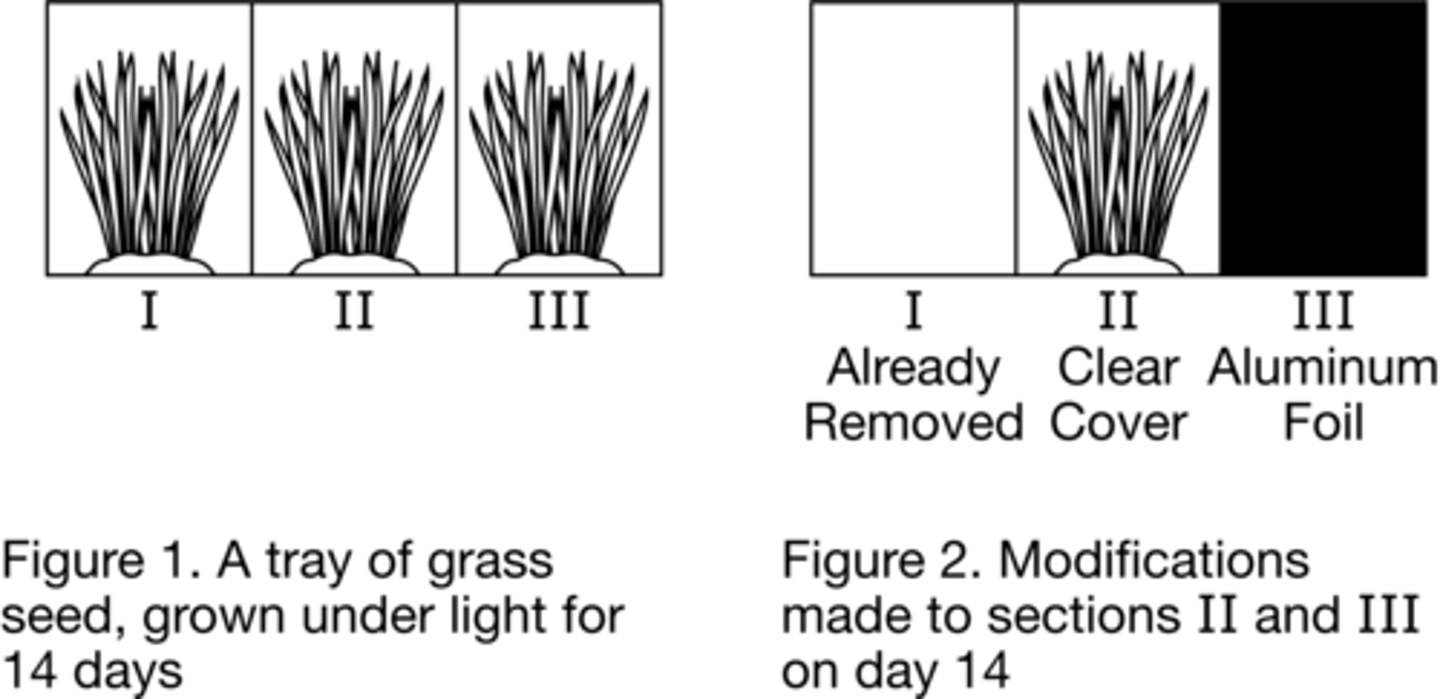
A student is investigating photosynthesis in plants. The student planted grass seeds in a tray with three sections and grew the grass under artificial lights for 14 days (Figure 1). After 14 days, the student collected all of the grass from section I and recorded its mass (Table 1). The student then placed a clear cover over section II and placed an aluminum foil cover over section III (Figure 2). The student then placed the tray back under the artificial lights for even additional days. On day 21, the student collected and measured the mass of the grass from sections II and III (Table 1).
Which of the following best explains the observed differences in mass between the grass in section I after 14 days and the grass in section III after 21 days?
Mass lost by cell respiration in section III was not replaced by photosynthesis
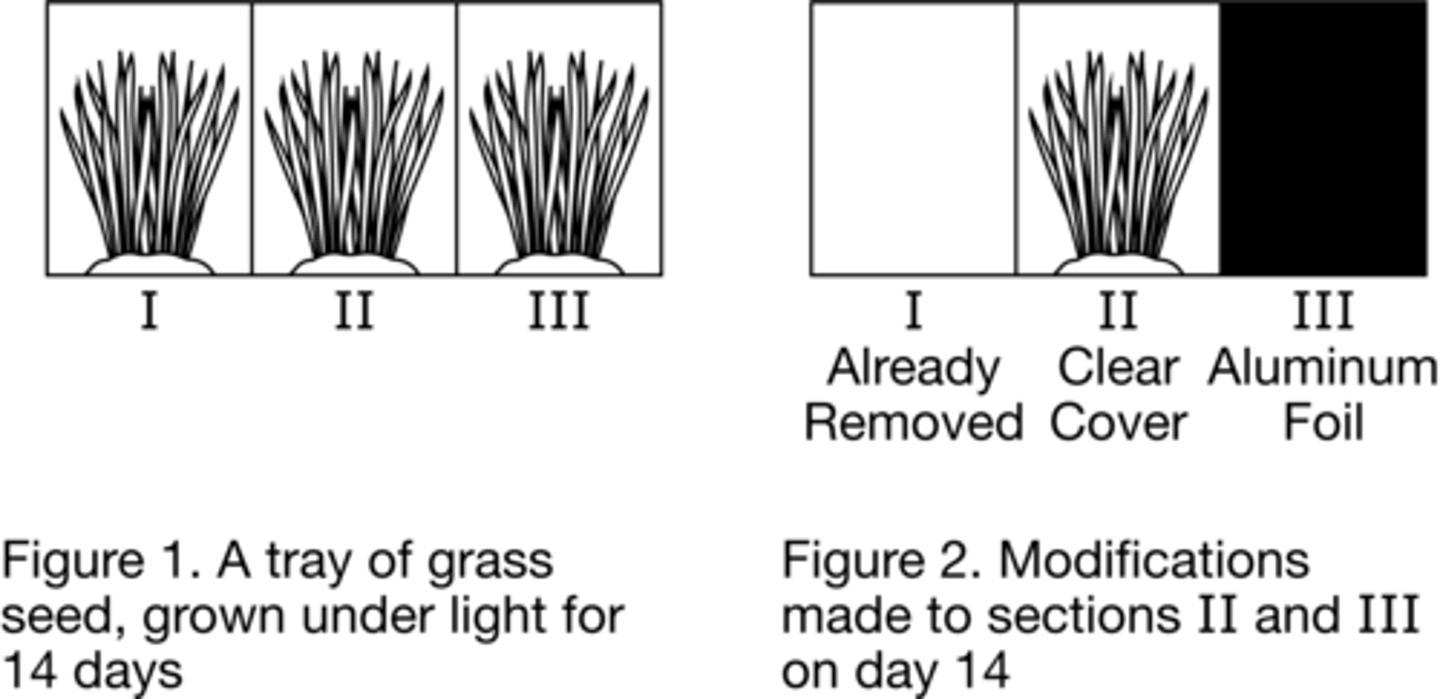
A student is investigating photosynthesis in plants. The student planted grass seeds in a tray with three sections and grew the grass under artificial lights for 14 days (Figure 1). After 14 days, the student collected all of the grass from section I and recorded its mass (Table 1). The student then placed a clear cover over section II and placed an aluminum foil cover over section III (Figure 2). The student then placed the tray back under the artificial lights for even additional days. On day 21, the student collected and measured the mass of the grass from sections II and III (Table 1).
Which of the following best explains the connection between energy, growth, and maintenance of an ordered system in the experiment?
Energy input from light is required for the grass to grow and maintain an ordered structure.
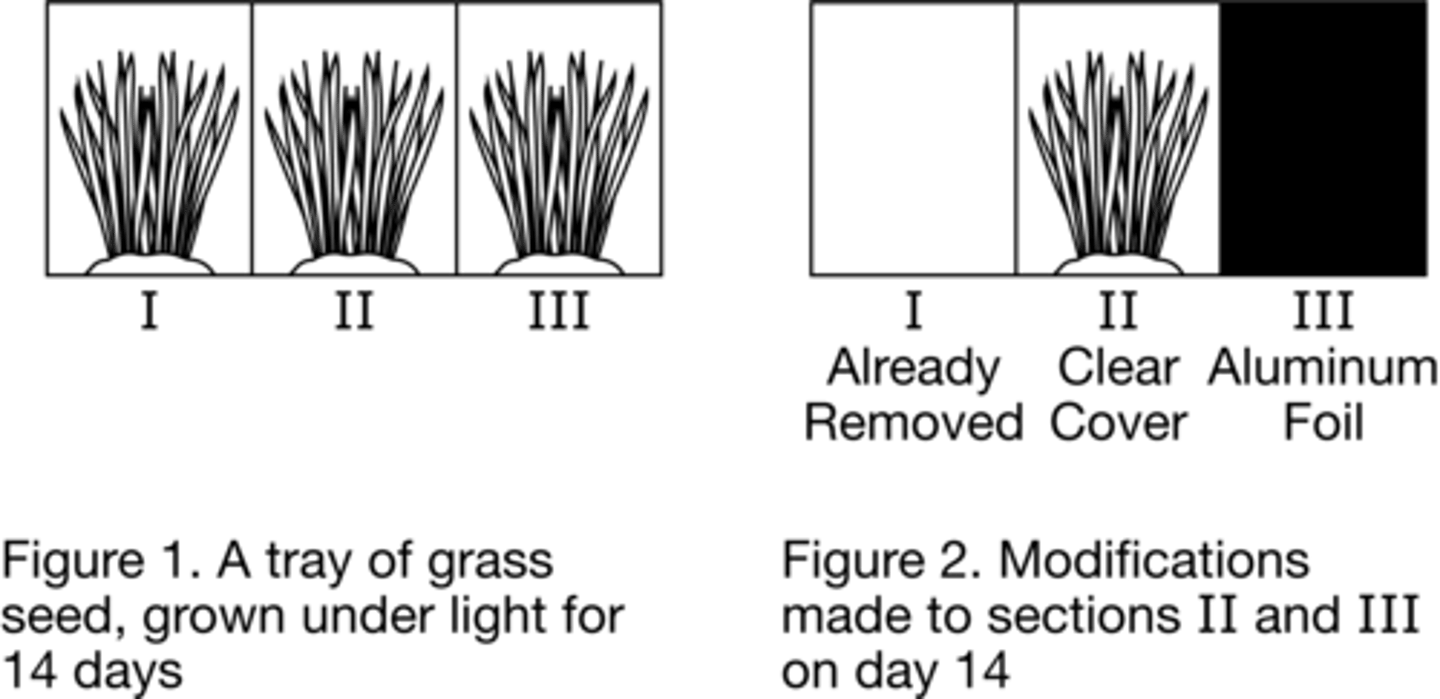
A student is investigating photosynthesis in plants. The student planted grass seeds in a tray with three sections and grew the grass under artificial lights for 14 days (Figure 1). After 14 days, the student collected all of the grass from section I and recorded its mass (Table 1). The student then placed a clear cover over section II and placed an aluminum foil cover over section III (Figure 2). The student then placed the tray back under the artificial lights for even additional days. On day 21, the student collected and measured the mass of the grass from sections II and III (Table 1).
Based on the data, which of the following is the most likely effect of a period of increased volcanic activity that significantly decreases the amount go sunlight reaching a particular ecosystem for several years?
There will be a decrease in the population sizes of most species and a decrease in the number of trophic levels
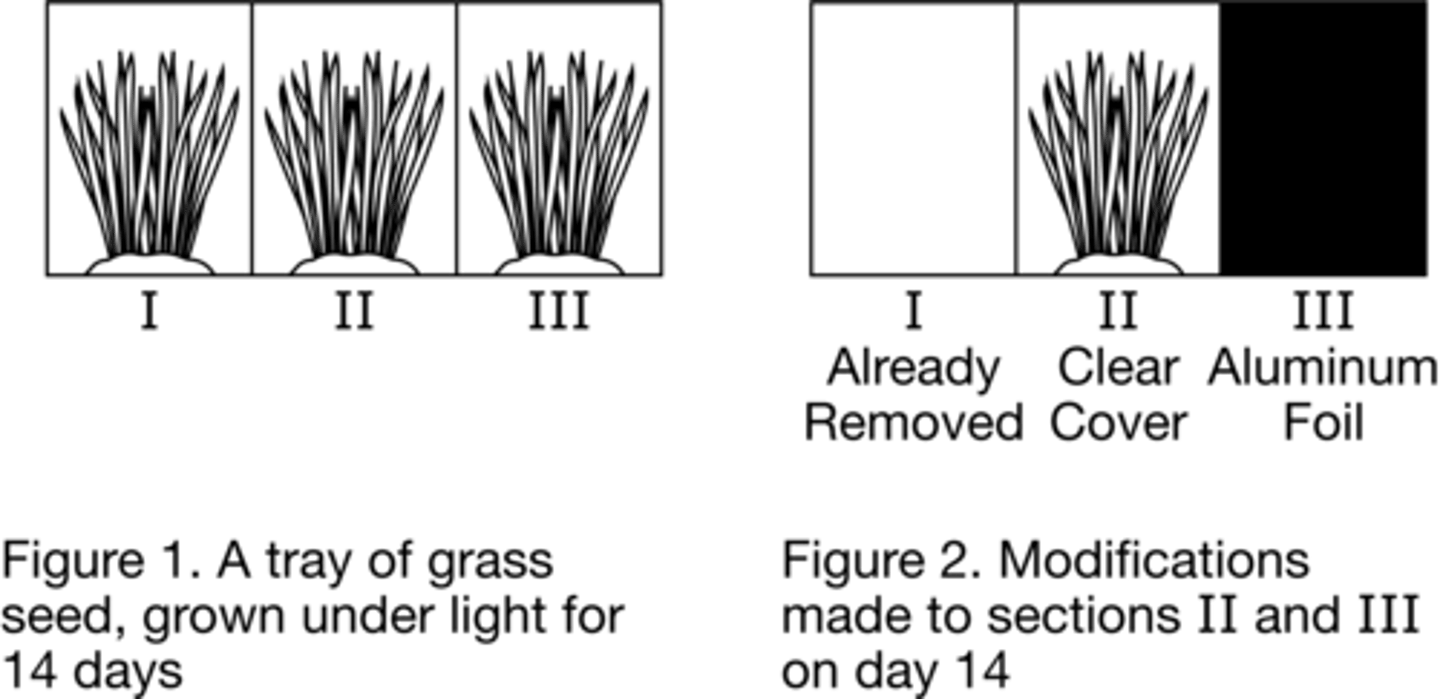
A student is investigating photosynthesis in plants. The student planted grass seeds in a tray with three sections and grew the grass under artificial lights for 14 days (Figure 1). After 14 days, the student collected all of the grass from section I and recorded its mass (Table 1). The student then placed a clear cover over section II and placed an aluminum foil cover over section III (Figure 2). The student then placed the tray back under the artificial lights for even additional days. On day 21, the student collected and measured the mass of the grass from sections II and III (Table 1).
Which of the following is a approximate null hypothesis for the student's experiment?
The presence of light has no effect on the mass of the grass

The amino acid in Figure 1 is found in a region of a polypeptide that folds away from water. Which part of the amino acid most likely contributes to the hydrophobic behavior of this region of the polypeptide?
Methyl (CH2) group
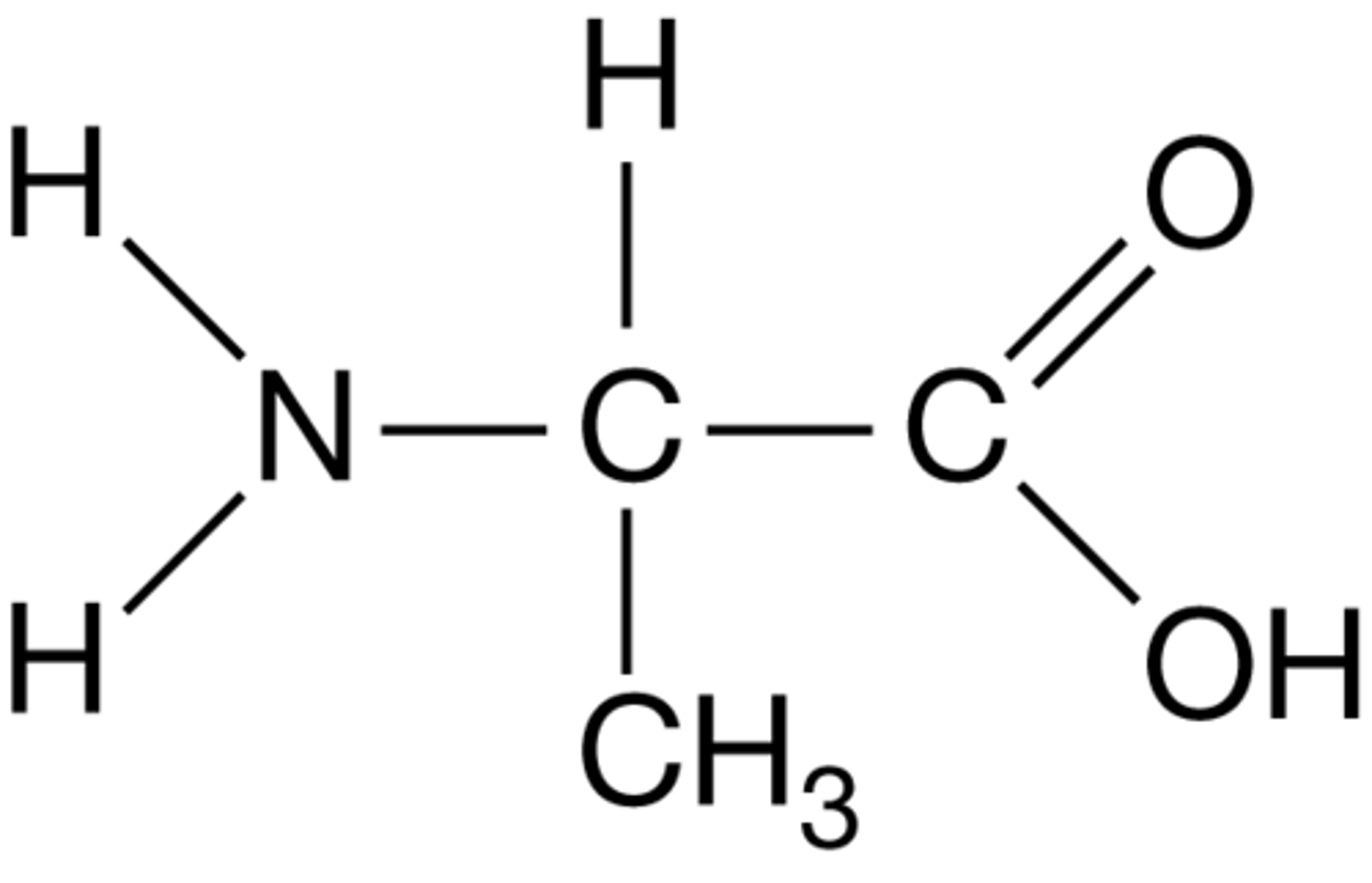
A researcher observes that when two heterozygous plants with red flowers are crossed, they resulting offspring include plants with red, white, or pink flowers. The researcher proposes the null hypothesis that flower color is the result of independent assortment and incomplete dominance. The researcher calculates a chi-square value of 7.3. Assuming two degrees of freedom, which of the following is the correct interpretation of the chi-square analysis, using a p-value of 0.05?
The null hypothesis should be rejected because the critical value is less than the calculated value.